19 June 2024

INTRODUCTION
The international covered bond benchmark segment, which started as an interbanking market-making (head to head) market in the 90s, transformed into a pure investor market-making market. A functional repo market constantly increases the liquidity of the covered bond market, as a consequence of which the covered bond benchmark market is one of the most significant and liquid market segments. Covered bonds are viewed in different ways: thanks to their nature and rating some view them as part of the rates world, others clearly see credit elements and consider covered bonds as the strongest product in the credit world.
As is the case for any other market in the rates or credit world, the covered bond market faces regulatory requirements which result in a more prudent approach to trading books in terms of balance sheet allocation. In short, while bank inventories have gone down in general. investors are receiving competitive prices for significant sizes from the secondary market leaders and when more limited trading books are axed.
However, the tide has turned, as the covered bond market started to grow again in 2022 after it had been shrinking for two years after the outbreak of the Covid-19 pandemic, which induced central banks to introduce large monetary support measures. These are now (gradually) coming to an end. Furthermore, the Eurosystem decided to first stop purchasing covered bonds in the primary market from March 2023 onward, while it also reduced monthly reinvestments of principal amounts of maturing covered bonds bought under the third covered bond purchase program (CBPP3) that it started back in 2014. Moreover, it completely withdrew from the covered bond market in July 2023, as the central bank will no longer reinvest maturing covered bond principals at all. At the same time, issuers have increased the average new issue size of new deals in recent years. This probably signals a break with the trend seen in recent years, with EUR 500mn becoming more and more the standard benchmark size for issuers. In other markets such as GBP, issue sizes have increased, as more than half of new deals had a minimum issue size of GBP 1bn from 2019 onward, up from GBP 500-750mn before. Meanwhile, in USD’s the “regS only” market often targets 600mn (to match the regulatory important 500mn + EUR equivalent) while 144a or SEC registered deals are often larger than/or at least USD 1bn. The Swedish or Danish Kroner Covered benchmarks can grow over time to a significant size often larger than in Euro or Dollar benchmarks. Obviously smaller benchmark volumes often lead to smaller secondary turnovers given that the various covered bond markets are dominated by a majority of buy and hold investors.
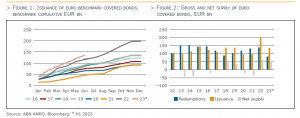
In summary, it indeed seems that liquidity conditions are further improving, after it had been negatively affected by a few years of negative net supply, lower-sized deals, a change of regulatory requirements and the nature of the investor base, especially the ECB as big buy and hold. In fact many traditional investors perceive the covered bond benchmark market now as way more liquid and tradeable, with the caveat we touch on a little later. Gross supply of euro benchmark covered bonds reached almost EUR 140bn during the first half of 2023, which was a new record, and followed upon the EUR 200bn of euro benchmark issuance during 2022 as a whole, which was also a new record. Repayments of the amounts borrowed in the ECB’s targeted longer-term refinancing operations (TLTRO), large refinancing needs due to redeeming covered bonds, relatively favourable new issue conditions in the covered bond market, and issuers anticipating the exit of the Eurosystem from the covered bond market, were all factors supporting new supply in H1 2023 as well as 2022. Furthermore, covered bonds once again proved their crisis-proof nature during the outbreak of banking turmoil following the failure of some US regional banks and the rescue of Credit Suisse in Europe in March 2023. Covered bond spreads were hardly affected, while covered bonds were the asset class to re-open the primary market after a two-week drought. Despite investors generally shifting into a more risk-off mode, conditions in the primary market for covered bonds remained relative good during these turbulent times, with issuers being able to place large amounts of covered bonds with investors. The large volume of new supply of euro benchmark covered bonds also implied that net supply with EUR 56bn was firmly positive in H1 2023. This followed upon the EUR 62bn of net positive supply in 2022. This, in turn, has more than compensated for the shrinkage of the covered bond market in 2020 and 2021 (in total net supply was EUR 59bn negative during these years). Positive net supply as well as the exit from the Eurosystem from the market should support liquidity in the covered bond market.
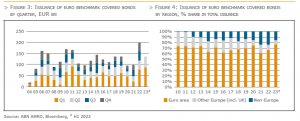
A regional breakdown (see graph above right) shows that euro area issuers account for the majority of new issuance, with their share also having risen. Their share rose to 77% of total issuance in H1 2023, up from 67% in 2022 (and 62% in 2021). This reflects for a large part France and Germany, the largest markets of euro benchmark covered bonds, although issuance from Austria and the Netherlands remained also rather strong in H1 2023. Meanwhile, non-European issuers lost some ground in 2023 so far, mostly reflected smaller amounts of issuance from Canadian banks in 2023, following the record amount of EUR 30bn that they issued in 2022. Finally, issuance from other EU countries remained fairly stable at 8% of total issuance in H1 2023, although it is well below the average 16% share, they had in the past ten years. The drop can probably be explained that these issuers can fund themselves cheaper in the domestic market rather than the euro-denominated covered bond market.
The fact that net supply was so positive this year as well as last year, has also been reflected by a rise in the total outstanding volume of euro benchmarks in the covered bond indices. The Bloomberg-Barclays euro covered bond index had, for instance, an outstanding amount of EUR 929bn in June 2023. This marks a 13% increase compared to a year ago and a 20% increase versus June 2021. It also brings the total amount of the index back at levels last seen in 2011/12. The number of bonds in the index rose to more than 1,000 last year and kept ever increasing, reaching 1,077 in June 2023.
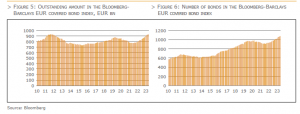
Let us again look at the evolution of the investor base as an angle for liquidity. If the share of buy-and-hold investors has risen in the past few years, this should have reduced liquidity of covered bonds. The graph below left shows the average allocation share per investor type in new euro benchmark deals. The graph nicely illustrates the crowding out impact of the Eurosystem’s CBPP3, but also the impact of the central bank’s exit in 2023. The share of central banks/SSAs rose again after the Eurosystem’s restart of net covered bond purchases at the end of 2019 (the Eurosytem only reinvested maturing principles between January and October 2019), with the share of central banks/SSAs rising to 25% in 2020, up from 16% in 2019. It’s share increased further to 26% in 2021, reaching even 29% in 2022. However, its share has dropped to 19% in 2023 so far, reflecting the central bank’s end of covered bond purchases under CPBB3.
The higher share of central banks during CBPP3 came at the expense of other investors. Asset managers have seen the biggest drop in their share, to 24% in 2022 from 32% in 2019. As these can be regarded as the most active portfolio managers, it seems fair to conclude that the change in the investor base in recent years has not supported liquidity of covered bonds. Interesting to note is that the share of asset managers has not (yet) increased following the Eurosystem’s exit of the market. Their average allocation share in new deals has been 23% in 2023 so far, slightly lower than the 24% seen in 2022. This implies that it were mainly banks that have replaced the Eurosystem in the primary market. Indeed, the participation of banks in new deals has jumped to above 50% in 2023, up from 41% in 2022 and 31% in 2016. The rise in the share of banks reflects that covered bonds are an attractive asset class in their LCR portfolios. Unfortunately, most banks are buy-and-hold investors, so this does not support liquidity in the end. Ending on a more positive note is that it is likely that the share of central banks will drop further, with that of asset managers likely rising. This should support liquidity (see also chapter 1.7 about the investor survey).
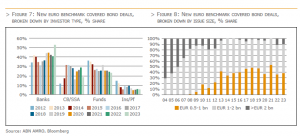
Finally, the larger the issue size, the better the liquidity. Also in this respect, there are positive developments, with issuers having increased deal amounts. The graph above right depicts the share of new deals broken down by issue size. The share of deals with an issue size below EUR 1bn was 39% in the H1 2023, which was slightly higher than the 36% share in 2022, but significantly lower than the 46% average in the prior five years. This means that the majority of new euro benchmark deals has a minimum deal size of at least EUR 1bn. In 2023, 61% of new euro benchmark covered bonds had a size of at least EUR 1bn, which compared to 64% in 2022, and an average of 54% during 2017-2021. More than 10% of new euro benchmark deals even had a size above EUR 2bn, which has become rare since 2013, as more than 30% of new deals had at least a size of EUR 2bn during 2004 and 2012. In any case, the rise in deal sizes suggest that liquidity in the covered bond market should have improved this year, especially when taken together with a lower participation of central banks.
Covered bond market liquidity and the end to APP purchases
The ECB Governing Council meeting in June clarified that Asset Purchase Programme (APP) reinvestments will be discontinued as of July 2023. This means that the covered bond purchases of the Eurosystem are likely to be reduced markedly. After almost nine years of CBPP3 buying, this is a major step for the covered bond market’s liquidity. As a result, market liquidity is likely to improve going forward, but the recovery is likely to be a slow and gradual process. This is backed by a recently published study about the long-term liquidity reaction to the CBPP3 and its net stop in 2019.
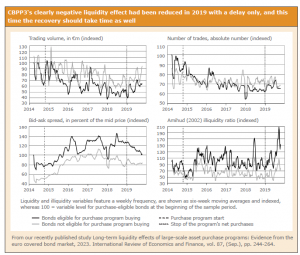
In the study, various liquidity measures were evaluated, such as trading volume and bid-ask spread of € benchmark covered bonds from 2014 to 2019. The analysis uses publicly available data and adjusts for the usual liquidity factors such as bond size, age, risk, etc. It substantiates a significant effect from the purchase programme period and actual purchases: CBPP3 had positive liquidity effects initially, but noticeably negative ones in the long run, which persisted well after the end of net purchases. Both effects result from the interaction between positive flow and negative inventory dynamics.
Specifically, liquidity on the secondary market for covered bonds increased considerably for several months directly after the start of CBPP3 purchases in October 2014. However, as the purchases progressed and the broader APP began, market liquidity decreased significantly. These trends can be seen even in the simple averages of liquidity ratios. The study provides scientific evidence of these findings at the individual bond level. The fixed-effects regression methodology compares CBPP3-eligible bonds, non-CBPP3-eligible bonds, and those that the programme purchased to a large or small extent. The liquidity effects are typically amplified for bonds affected by the programme to a larger degree; and the larger the programme’s purchases in the primary market, the greater the liquidity drain on the individual bond level. This suggests a relationship between liquidity declines and CBPP3 purchases. When net purchases stopped in 2019, liquidity recovered accordingly. However, it took several months to turn, and throughout the study’s observation period, liquidity did not revert to the level before the CBPP3 purchases.
Given the announced stop of gross purchases as of July 2023, the current CBPP3 scenario is ahead of the study’s setting, which focuses on a net stop only. At the same time, however, the programme’s footprint in the market has become even more entrenched since the 2014-2019 phase; net purchases have not been stopped for long. Therefore, it is likely that covered bond market liquidity today will again need a slow and gradual process to fully recover.
In addition, the investor base of covered bonds has fundamentally changed recently. While before the start of the CBPP3 the four investor groups banks, asset managers, insurers and central banks / official institutions each bought substantial shares of covered bonds on the primary market, bank investors dominate the buying since the gradual withdrawal of the Eurosystem (see also above). A temporary phenomenon are the so-called crossover investors, mainly funds which have Covered within their mandate but usually more focussed in credit markets, in anticipation of a general spread widening, they sold credit products like seniors and “parked” their assets in more stable and liquid Covereds, once their view is changing, they are likely returning to Credit markets. Apparently hardly any investor has been forced out of the market completely, but their demand relative to the issuance volume is notably smaller compared to the period prior to 2014.
As mentioned above, asset managers’ share in new issues has not increased with the CBPP3 reduction. In addition, splitting the public allocation data of new € benchmark covered bonds by maturity bucket, shows that the other investor groups – apart from bank treasuries – do not exhibit higher shares either. For covered bonds with maturities up to nine years, which are the typical preferred bucket for central banks and official institutions, the share of official institution buying other than the CBPP3 was roughly stable in 2023 compared to both years before. For long-term covered bonds beyond nine years, which are usually popular with insurers, these buyers account for less than one tenth of the allocated order books on average in 2023. Partly also explainable by the current shape of the yield curve with highest yields achievable at the front end of the curve. Before 2014, they accounted for three times as much. According to our market discussions, this is due to the losses in the fixed-income and alternatives sectors and the fact that some insurers have to meet puttable covered bonds. In the end, there are relatively little funds left for new covered bonds. Both effects of relatively low asset-manager, insurer and central bank demand could be amplified somewhat by the large issuance volume so far in 2023.
In sum, covered bond market liquidity is likely to improve with the end to the APP buying, but it is debatable how quickly and whether it will climb back to pre-2014 levels again.
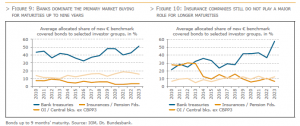
The Swedish domestic market for covered bonds is of great importance for the domestic capital market. Before Sweden implemented a law for covered bonds in 2004 a liquid market for mortgage bonds had been around since the beginning of the 80s. The outstanding volume of covered bonds in SEK was EUR 184.6 bn at year end 2022. That was more than twice as much as the outstanding volume of government bonds.
Swedish bond market investors appreciate liquidity. The large banks issue their covered bonds as benchmarks which mean that large amounts are issued and that several dealers are contracted to show both bid and offer prices. Also, only benchmarks are deliverable in the future contracts. When a new benchmark-bond is issued, the issuers make sure that the amount issued meets the requirements for a benchmark sized deal. After the initial day of issuance, the issuer can, without further notice, issue “on tap”. The benchmark bonds can amount to volumes of about SEK 60 bn. Sweden has a liquid and smoothly operating repo market with almost all banks involved in the trading. The issuers offer their market makers a repo-facility in their own bonds. The repo transaction is viewed as a ‘sell-buy back’ or ‘buy-sell back’ deal and the ownership of the security has to be transferred.
Overall, this system has been working for a long period of time. The recently implemented legislations have not been observed to have had any significant effects on the liquidity in the Swedish covered bond market. The Swedish Central Bank (Riksbanken) has been aggressive in its Quantitative Easing (QE) policies for some years. During the pandemic the Riksbank increased their buying of bonds. Before the pandemic they just bought government bonds but during the QE-period they have also been buying covered bonds and other bonds. The Riksbank owned 18 percent of the outstanding amount of SEK covered bonds in the end of 2022. The Riksbank is now ending QE and moves into QT and has started to sell government bonds. They will not sell their covered bonds, but they will stop reinvest in new covered bonds when old ones mature. Due to the short maturities of their holdings, their holdings of covered bonds will decrease fairly quickly. During the beginning of the pandemic there where an increase in trading activity but the activity has been diminishing throughout the pandemic. During the period of more intense QE the turnover in the market has decreased.

THE DANISH COVERED BOND MARKET
The type of bonds making up the Danish covered bond market fall into three major segments: callable bonds, bullet bonds and floaters with or without a cap. The market comprises a great number of securities, but the vast majority of the nominal value is concentrated on a relatively small number of large series. With an outstanding volume of EUR 463 bn the Danish covered bond market is the largest in Europe. Trades in mortgage covered bonds are reported to Nasdaq Copenhagen, including over the counter trades and excluding repos.
Average monthly turnover on Nasdaq Copenhagen including over the counter trades and excluding repos in the period 2011 – 2022 came in at around DKK 660 bn (app. EUR 89 bn). In 2022 average monthly turnover was DKK 903 bn (app. EUR 121 bn), cf. Figure 1. On average this means that approximately 26 percent of the outstanding volume was traded every month of 2022. Foreign investors have a positive effect on market turnover and liquidity. By end of 2022 foreign investors owned around 22 percent of Danish covered bonds.
The financial turmoil and the increasing interest rates that impacted the financial markets globally in 2022 also affected the Danish covered bond market, but the market remained open for trading and the Danish covered bond market cleared every day and hence the Danish mortgage banks were able to supply mortgage loans at market rates also through this period of financial stress. The market maker function of universal banks is handed a central role providing liquidity in the covered bond market, as professional investors are mostly unwilling to buy in small batches. Market makers are the main source of liquidity in the Danish covered bond market.

Pass through, tap issuance, quarterly refinancing auctions and frequent early repayment activity are all characteristics of the Danish covered bond market, which among other more universal factors affect the level of market turnover. The strict balance principle deployed by Danish mortgage banks incorporates pass through of payments between borrowers and investors. Covered bonds are tap issued and sold in the market on a daily basis in sync with borrowers’ demand for mortgage loans. Following the initial tap issuance, mainly bullet bonds and to an extent floaters, are refinanced by the issuance of new bonds at refinancing auctions over the life of the loan.
Borrowers’ early repayments influence liquidity in the Danish covered bond market. Any Danish covered bond can be bought back by the borrower at the current market price and delivered to the issuing mortgage bank – the buyback option – or in the case of fixed rate mortgages it is also possible to redeem at par. This type of early redemption activity gives rise to an increase in transactions both when bonds are bought back (the buyback option), and when new bonds are issued.
The rising interest rates in 2022 meant that the prices of fixed rate mortgage covered bonds went down and hence many borrowers with fixed rate mortgages reduced their outstanding debt using their buyback option to repay their existing loan at a price well below par and remortgaged to a new loan at the existing market rates with a lower outstanding debt. Both borrowers buy back of bonds and the issuance of new bonds in the primary market financing the remortgaging was a driver for turnover in 2022.
By Joost Beaumont, Chairman of the ECBC Statistics & Data Working Group and ABN AMRO,Jonny Sylvén, ASCB, Lars Ravn Knudsen, Finance Denmark, Steffen Dahmer, J.P. Morgan and Dr. Michael Weigerding, former Commerzbank